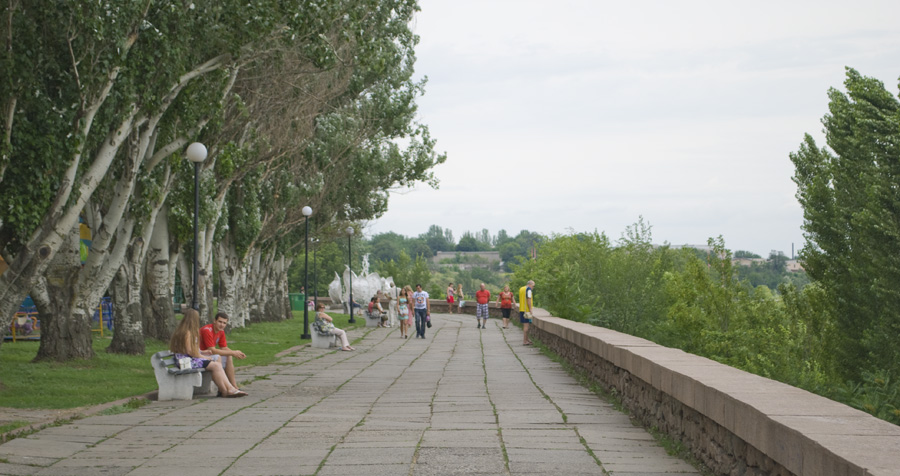
Nikolaev catacombs: a network of underground passages
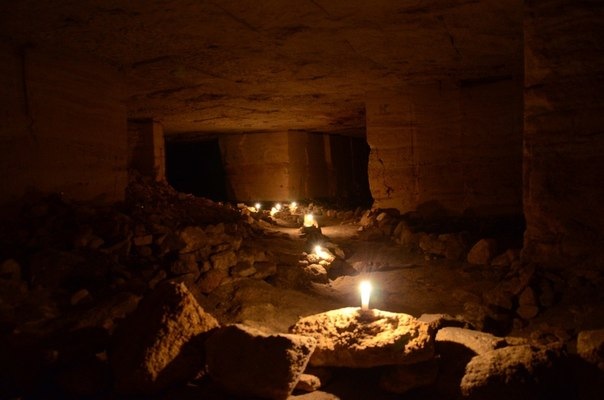
Beneath the city are naturally formed passages and man made passages. The catacombs can have two or three, and even more, levels. Some are at a depth of 3-4 meters, others go 8 to 20 meters deep. The first level of the catacombs is located under the old part of the city. These are old and not so deep basements and cellars, connected with each other. The second level is an ancient aqueduct, built in 1820-1830. Scientists speculate about the existence of another, deeper level of dungeons. The plan-scheme, created by archaeologist Andrew Maystrenko, shows stone-paved tunnels. No one has done a systematic search of the catacombs. In the 1920s, a basement and its adjecent tunnels were explored. Some information was found in reports of pre- and postwar companies. In 1954, the surveyor Matveev reported to the Department of Architecture of Mykolayiv about a tunnel going towards Kherson.
In 1956, a large expedition by the navy was organized under leadership of engineer Alexander Vasilyevich Alekseyev. They wanted to make a detailed description of the tunnels. In 1992, the Mykolayiv municipal council decided to have the underground structures surveyed. Unfortunately, many tunnels were destroyed and further research was impossible.
There are many different explanations about the origins of the catacombs. Version one: according to documents in the archives, for building Mykolayiv a lot of stone was needed. The stone was quarried very close by, on the Mykolayiv peninsula. Apart from stone also lime was extracted, mainly from the banks of the Bug river estuary, within the city limits. Also within the city itself stone was quarried. These quarries had a depth of 20 - 30 meters. These formed deep and branched out catacombs.
According to the second version, the catacombs were specially built. In 1855, when Mykolayiv was under siege, the city was fortified by General E.I. Totleben, who engineered the defenses of the city of Sevastopol. Based on the experience in Sevastopol, underground galleries (or mines) were dug in advance towards the most important positions in Nikolaev. Also, construction of 'mines' is associated with the Turks, because yataghans (Turkish swords) were found in the tunnels.
The third version is that the catacombs are nothing else but a water supply system, built in the 1820s-1830s under supervision of A. Rokus de Charleville. The length of the tunnel, under Admiralskaya Street alone, is five kilometers, but this water main is only a small part of the whole underground system. (nikolaev-city.com)
Avenue of military glory

This is a memorial, set up in the recreational park 'Victory', in memory of people from Mykolayiv, who lost their lives during the war in Afghanistan. Today it is one of the most well-kept places in the park, where it is always crowded. In addition to the obelisk and orthodox bell tower there is a small outdoor exhibition of military equipment and weaponry. Every year, on February 15th, the day when Soviet troops withdrew from Afghanistan, a citywide memorial service is held, commemorating these soldiers. (nikolaev-city.com)
Canyon of the Mertvovod river

The river Mertvovod flows throught this canyon, also called the 'Valley of the Devil' or 'Little Crimea'. The canyon stretches three kilometers, from the village of Aktov up to the village of Petropavlovk. Covering an area of about 250 hectares, the canyon reaches depths of 40 to 50 meters. The canyon has a combination of ecosystems, forests and rocks, unique in Europe, but resembling closely to the big and famous canyons in North-America.
The water contains high concentrations of hydrogen sulfide. The high walls measure up to a hundred meters. The unique natural beauty attracts tourists from all over Europe. The difficult terrain makes it impossible for rafting, but it is attractive tof extreme sports, like rock climbing.
Since 1994 the river, its shores and the canyon form the landscape park 'Granite-steppes of the Boog'.
The unusual conditions of the region made it possible for a unique ecosystem to form. Because of its unique characteristics, this place was special to the Scythians. They performed rituals here and buried their kings between the flows of the Mertovovod river and the Southern Boog. (nikolaev-city.com)
Trikratsky forest
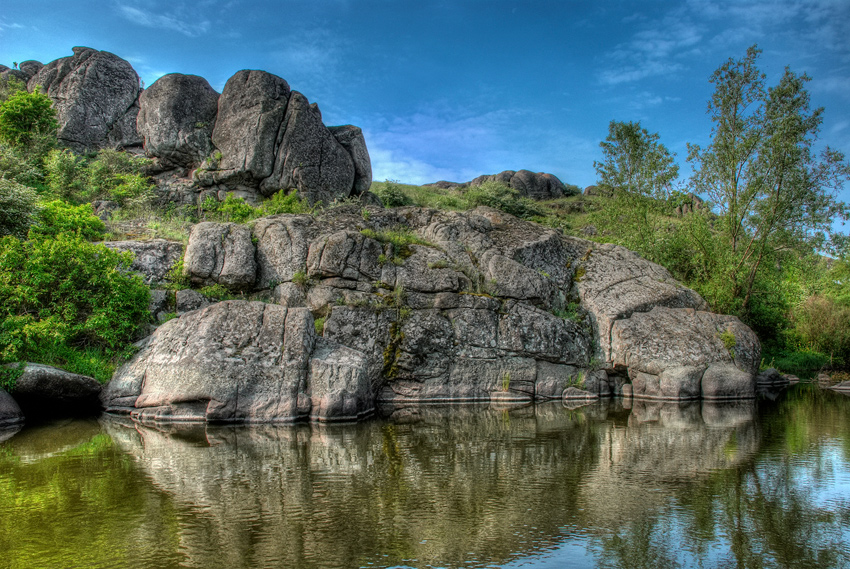
This forest is a great and wonderful reminder of nature, located in the Mykolayiv region in the district of Voznesensk not far from the village of Trikraty. This forest is considered as a unique natural reserve. The total area is 247 hectares. There are many streams, river rapids and fountains. Between the many kinds of trees about 350 oaks have been standing here over 120 years.
Many animals and birds live in this forest: bison, deer, roe deer, as well as a colony of gray herons. There are so many trails and bridges, that someone could get lost in the forest. There are guides and tourist organizations, who organize one day and two day tours through the forest.
Kinburn Peninsula
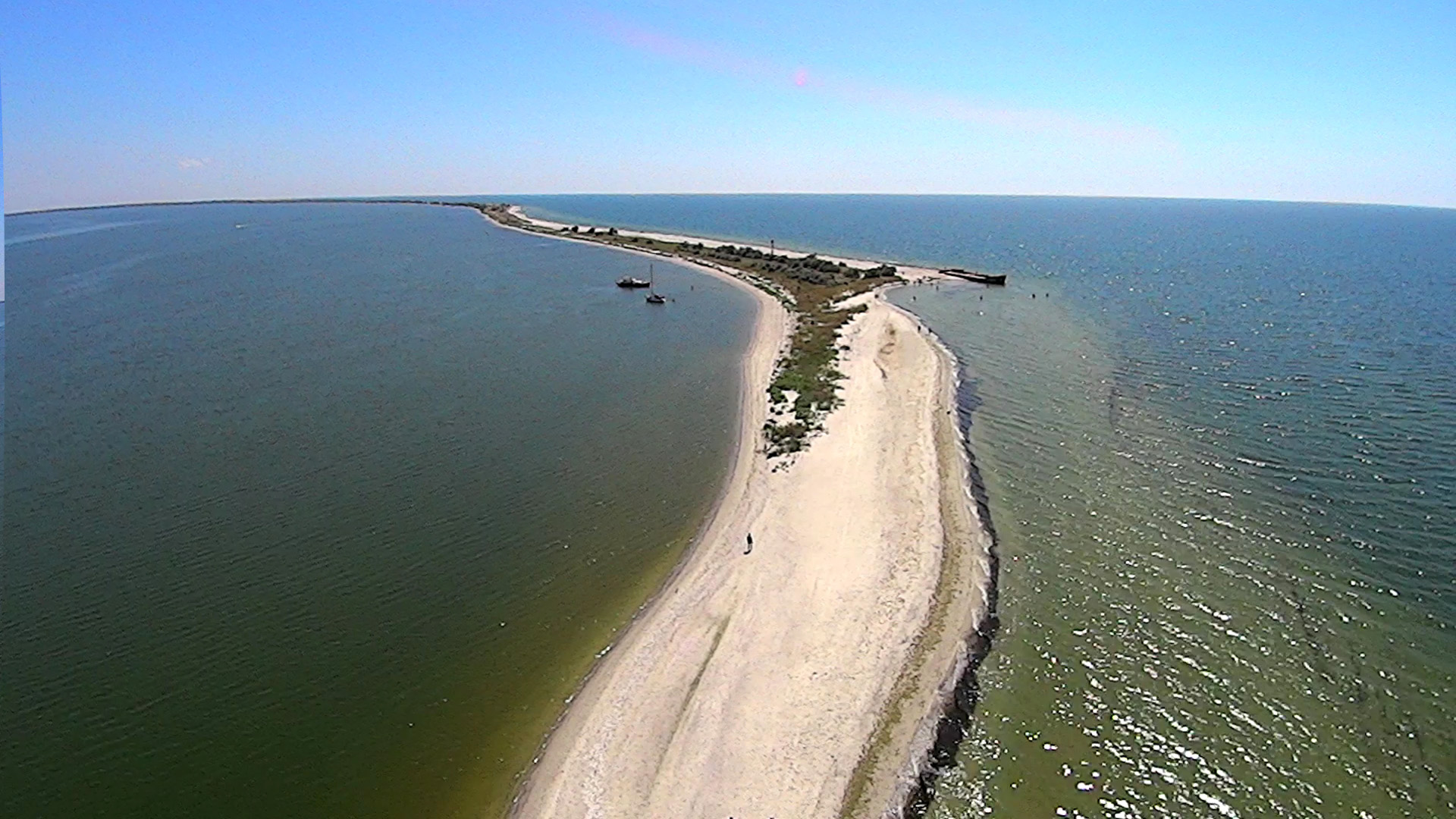
A quiet place, away from civilization, with nature still preserved in its original form. The Kinburn Peninsula - or Kinburn Scythe, because of the shape of the peninsula - has a unique microclimate. On one side there is the Black Sea with its salt water, on the other side the Dnieper river releases its sweet water into the bay. The land is covered with vegetation, like herbs and a pine and oak forest. Because of its abundance of herbs the Kinburn Peninsula is sometimes called 'an open-air pharmacy'. On the peninsula over 500 species of plants grow, many of which have medicinal properties. A few examples are chamomile, thyme, valerian, St. John's wort, mint, immortelle sandy, etc. In the pine forest you can find many white mushrooms.
One of the famous sights of Kinburn Peninsula is the Volyzhin forest, a remnant of the ancient forests of the country Gilea. The Greek historian Herodotus wrote that Gilea existed here in the 5th century BC. Then the Kinburn Peninsula was covered with a dense forest. The remains of the forest can be found today in patches with small oak trees, birch, alder and aspen. Water, heat, humidity and the scorching sun contribute to the fast rate of growth of trees and grass in the sandy lowlands.
In the Volyzhin forest live around 300 different species of birds, including the crane, mute swan and the white-tailed eagle. Over 60 kinds of animals are listed in the Red Book of Ukraine. Kinburn is one of the favorite habitats of pink pelicans.
Another attraction on the Kinburn Peninsula is one of the biggest places in Europe where wild orchids grow, in the outskirts of the village of Pokrovka. They bloom in early May.
There is also a lake with 'healing mud'. Bathing in this salt lake and applying the white clay and mud helps against ostreohondrosis.
History of the region
Because of its geographical location the Kinburn Peninsula has always been important. Some historians believe that during the times of Prince Svyatoslav on the island -not far from the island of Berezan- merchant ships anchored before the long journey across the Black Sea. The island had different names, in Greek it was Borisfenida or Old White Beach (Bіloberezhzhya). In times of Kievan Rus' there was a trading post of Kiev merchants, along the main Kievan Rus trading route, 'from Varyag unto the Greeks'. The trade route connected the Baltic and Scandinavian countries with southern regions of Kievan Rus and the Byzantine Empire. Bread, handicrafts, silver, coins, furs, honey, wax, amber and weapons were traded for wine, spices, fruits, expensive fabrics and jewelry. (litomore.com.ua/resorts/kinburn)
Ochakov
Ochakov is an ancient city on the Black Sea coast close to Mykolayiv. In the past it was a Turkish fortress. When the first shipyard was built on the river Ingul, a war between Russia and Turkey was waged over the territory of the northern Black Sea coast. Russian troops were led by commander Alexander Suvorov. The decisive battle for the Turkish fortress Ochakov took place in early winter of 1788, on St. Nicholas day. In honor of the saint and to commemorate the victory over the Turks, Prince Grigory Potemkin-Tauride named the new city Nikolaev (Mykolayiv).
Ratsinskaya Dacha

A state reserve of national importance, it is home to deer and roe deer, pheasants and hares, and also wolves. The Ratsinskaya dacha is the only territory in the former USSR where juniper trees grow. In 1836, the local landowner Earl V.P. Skarzhinsky brought these from North America and planted them here. (tic.mk.ua)
Berezan island

Berezan Island is a beautiful island in the Berezan bay, about thirteen kilometers from the city of Ochakov. On the north and east sides of the island the waters of the Dnieper river and the Southern Boog flow, and on the south and west sides the water from the Black Sea. There are no trees or bushed on the island, and no buildings. Only tall grass and flowers. Berezan is a small island; only 850 meters long and 200 meters wide at one end and about 800 meters wide at the other end. The special thing about this island is its history: it is at the heart of the 'Olvia' archeological reserve.
In ancient times, Berezan island was a peninsula and covered almost twice the area than in modern times. At the end of 7th century BC, an ancient Greek settlement of Berisfen existed here. Later, the ancient Greek state of Olvia was founded. On Berezan island, evidence shows that Cimmerians, Scythians, Romans, Greeks, Vikings, Goths and Turks have lived here. The island was on the trade route 'from the Vikings to the Greeks'.
In 1906, the leaders of the mutiny on the cruiser 'Ochakov' were executed on this island (Alexander Gladkov, Lieutenant P. Schmidt, Gunnery N. Antonenko and senior Bataller S. Chastnik). On the southern part of the island in 1968, a 15 meter tall monument, consisting of three oblisks was constructed. On either side it resembles a sail filled with wind; a symbol of the marine element, the courage and the perseverance of the sailors.
The island has many unofficial names. The Russian princes nicknamed it 'Dolsky island', the ancient Greeks called it 'the Holy Eforie', it is also known as 'the island of Lieutenant Schmidt', and according to the great Russian writer Alexander Pushkin, this island is the legendary island of Buyan from the 'Tales of Tsar Saltan'.
More recently, archaeologists made a unique discovery; an ancient pottery kiln, which is about 2.5 thousand years old. This was announced by Deputy Head of the Berezan ancient archaeological expedition, Alexander Smirnov. "On the island of Berezan, we found this ancient furnace. Its size suggests that pottery production was established here. Local craftsmen were able to work well with ceramics and had the necessary equipment. And since last year a furnace for manufacturing lamps was found here as well, it can be safely said that in this place there was a 'potter's quarter'," said Deputy Head of the Berezan ancient archaeological expedition, Alexander Smirnov.
According to Smirnov, these findings suggest that the Greeks, who lived on the island Berezan, were able to produce everything they needed for daily life, as well as provide themselves with 'own products'. Archaeologists quite admit that most of the island was flooded, so the research is also being conducted on the seabed. (nikolaev-city.com)
Sivashky (Arkasovsky) public garden
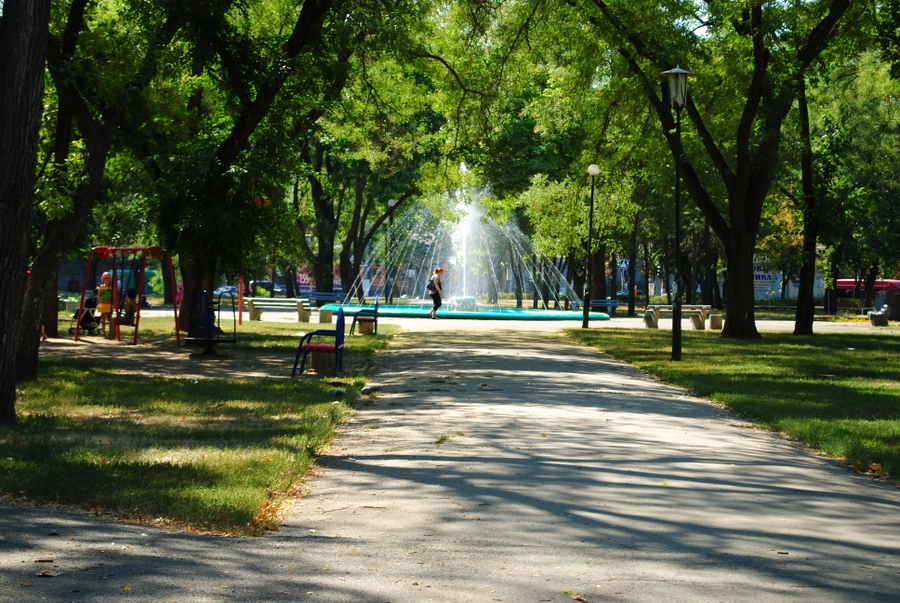
The Arkasovsky Public Garden is the first public garden in Nikolaev. The original name was Platz-front square, established in 1869 by order of the military governor B.A. Glasenapp.
The square was situated between the streets of Admiralskaya, Pushkin and Nicholas. In the second half of the nineteenth century, the square was landscaped and turned into a garden, called 'the public garden at the palace'. Diagonal tracks are layed to form the St. Andrew's flag, which is the Russian naval flag.
In 1882, it was named 'Arkasovsky Garden' in memory of admiral N.A. Arkas, the chief commander of the Black Sea fleet and military governor of Nikolaev and Sevastopol in 1871-1881. On the west side of the Arkasovsky Garden, the building of the Mariinsky female grammar school was built in 1890 by architect E.A. Shtukenberg (now the Ukrainian N.N. Arkas gymnasium). In the early twentieth century, the garden was renamed to Mariinsky Garden. Later, it again changed name to Sivashky Garden, in honor of the Sivash Division, which during the Civil War freed the Crimea, and then was stationed in Nikolaev.
On the 100th anniversary of the defeat of Napoleon's troops, a memorial was erected in the park in 1912, titled 'Heroes of the Patriotic War of 1812' by sculptors Biodzholi and Riha and the architect E. Shtukenberg. The monument stood only a short time. In 1922, the monument was transformed into a monument for the soldiers of the Sivash Division. Only the granite obelisk is preserved until this day.
Mykolayiv Chess Club
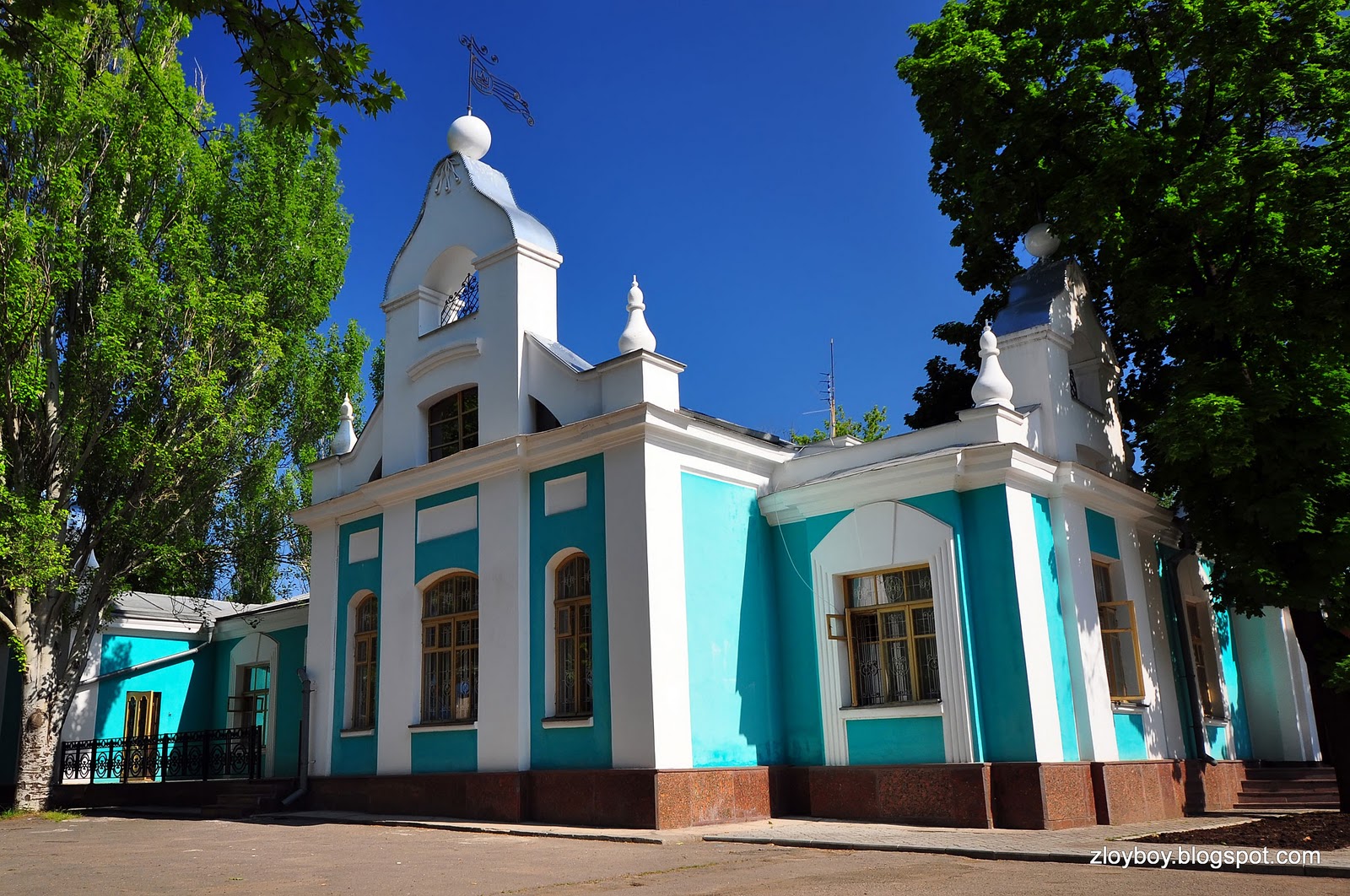
Chess Beauty Palace is an outstanding sight of Nikolaev. At the end of 1988 at the Naval Boulevard, an old, ramshackle house became vacant, where previously the city communications department housed. The architect Sergei Tarasov, his son and his main assistant Sergey Shelest opened a regional chess club in 1999 here.
In that beautiful, comfortable house, close to where the waters of the Ingul river and Southern Boog merge, are the pink hall for events and three rooms (green, yellow and granite) for training with young players. The club, since its early days, became the most popular center for chess and for cultural meetings.
The full name of the club's children's and youth sports school is 'Regional chess and checkers club'.
Black Sea shipyard
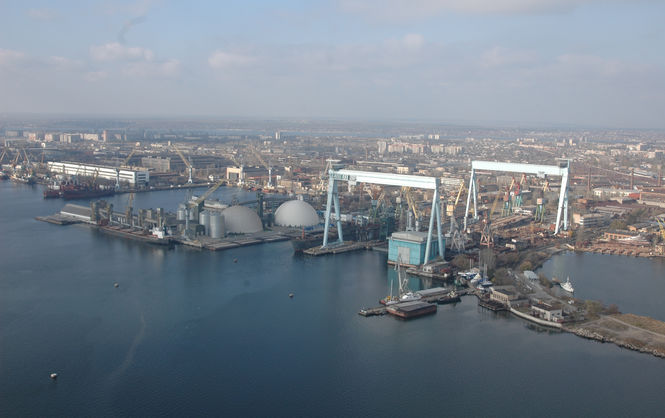
This shipyard was one of the two largest plants in the Russian Empire and then in the USSR for shipbuilding. Constructed in 1896-1897 as two different adjacent plants: ’Nawal’ (1897) and 'Black Sea mechanical and boiler plant' (1896). The plant immediately became the main shipbuilding factory for the Black Sea fleet, both merchant ships and war ships.
The first major project was equipping the Russian battleships 'Prince Potemkin-Tauride', 'Chrysostom', 'Eustace' and the cruiser 'Cahul'. In 1901, they started to build ships themselves and a series of destroyers were constructed. In 1908, 'Nawal’ and the neighbouring plant were merged into the largest factory in southern Russia. Since then, large-scale construction began: underwater mine layers, 'Novik' class destroyers and mine cruisers. But a milestone is the year 1911: the production of two ’Dreadnought’ class battleships.
In 1915 the shipyard delivers the Dreadnought battleship 'Empress Catherine the Great'. This battleship had an artillery duel with the famous German-Turkish 'Goeben'. Because of the revolution and the civil war activities ceased in 1918-1925.
After that, the plant was working again, but under the new 'revolutionary' name of Andre Marty. At first, constructing light ships and civilian vessels, then moving on to building cruisers, destroyers and submarines. Also icebreakers and pontoons were constructed. In 1938, after a general reconstruction, the factory started to build the battleship 'Soviet Ukraine' (which was never finished).
This is one of the plant’s prides: the cruiser 'Molotov' (1941), that fought in 1941-1943. The war brought a second break in the work: from autumn 1941 to summer 1944. Personnel, materials and tools were all evacuated by sea (as Odessa was also evacuated), so after the war production could quickly be resumed.
The Germans left the territory on March 27, 1944, destroying 95% of the infrastructure and almost all the buildings, slipways and workshops. The demolition of the factory allowed for easy upgrading to a new technological level. It was restored in the sense of building from the ground up, but at the same time preserving its cadres, and tooling. It already started to work at full capacity at the end of 1945.
After the war, the plant was restored and it became a multipurpose 'factory of factories' of ships, ahead of all three Leningrad’s shipyards. From 1945 until 1991, the factory produces many kinds of boats, ships, (military) vessels, submarines and aircraft carriers. During the Soviet post-war period more than five hundred vessels for trade, scientific research and fishing were constructed. nikolaev-city.com)
Necropolis: the old Mykolayiv cemetery
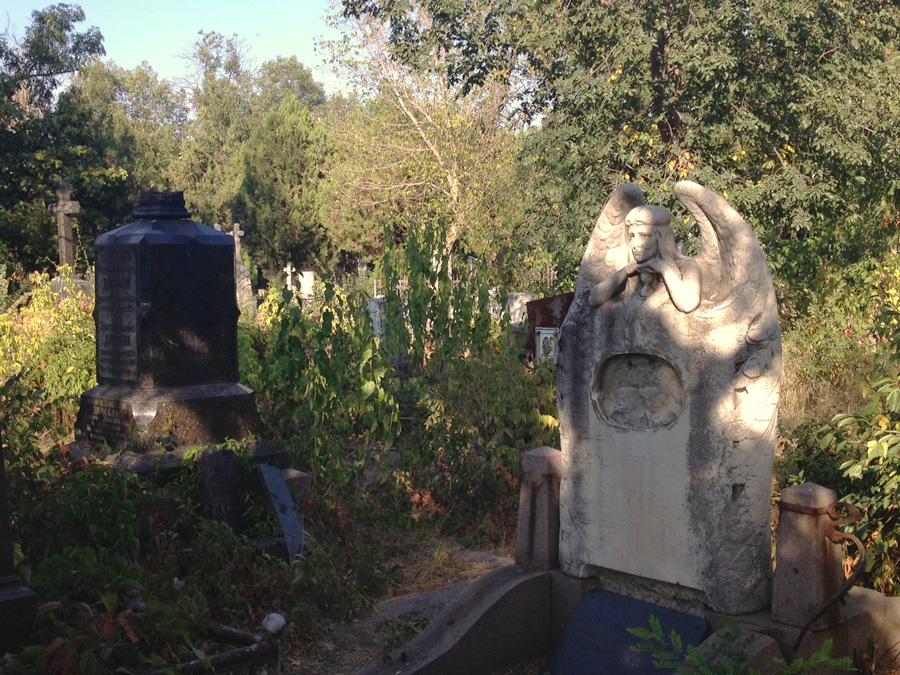
The old city cemetery, dating back to 1790, is located on the outskirts of the city on the banks of the river Ingul and consists of several parts. The largest part is the Orthodox cemetery where Catholics and Protestants were buried. To the north of it is the Old Believers cemetery and to the south, further away, the Jewish, Karaite and Mohammedan cemetery. The Mykolayiv city cemetery is very green and there are a lot of beautiful tombstones and crypts.
At the center of the cemetery stands the Church of All Saints. It was built in 1807-1808 'zeal naval officials Admiralty servants, merchants, burghers and commoners of the city of Nikolayev'. The church was rebuilt and enlarged in 1858, financed by the former churchwarden K.N. Sobolev. In 1876, I.F. Bartenev assisted by the former chief commander of the Black Sea fleet Adjutant General N.A. Arkas had the church surrounded by an iron fence. The church has two dedications: in the name of All Saints and in the name of Apostle-Evangelist St. John. In 1876, a two-storey chapel for funeral services was built, financed by N.A. Arkas.
Many famous and important historical figures are buried in this cemetery, and there are several monuments for those who fought in wars. Sadly, some graves and tombs fell victim to grave robbers.
Ingul bridge
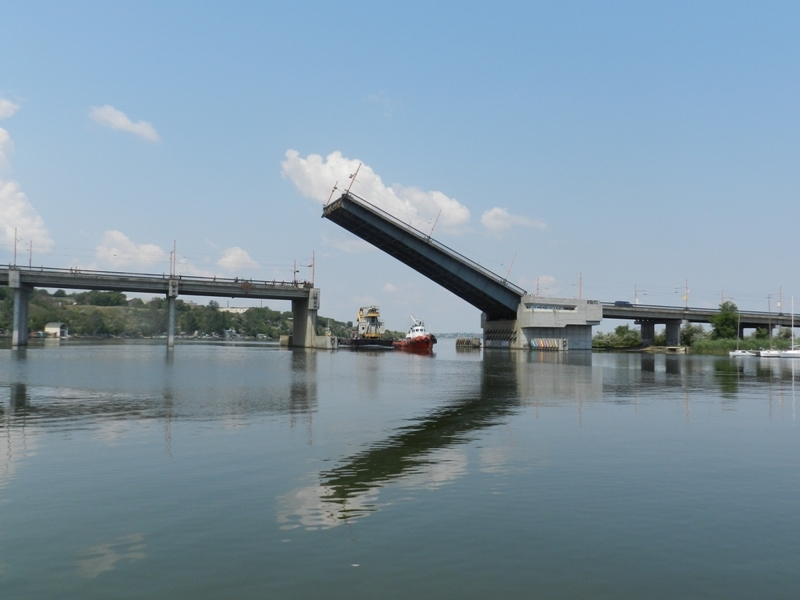
This is a drawbridge over the river Ingul with an adjustable span for passing ships and vessels. The bridge is located there, where they -immediately after the founding of the city in 1789- dredged the river so ships could pass through the Ingul river estuary. In order to be able to do this, a 'Farwaternaya mashina’ (literally from Dutch: vaarwatermachine, or fairway machine/shipping lane machine) was constructed. In essence it is a pontoon with scoops on the sides, set in motion by a huge wooden wheel on which people were walking. With this dredging machine they were able to clear the channel at the mouth of Ingul.
The bridge is 472 meters long, with approaches measuring 1,330 m. It is 18.5 m wide, with 4 traffic lanes and 2 sidewalks. It measures up to 33 meter high.
Mykolayiv airport
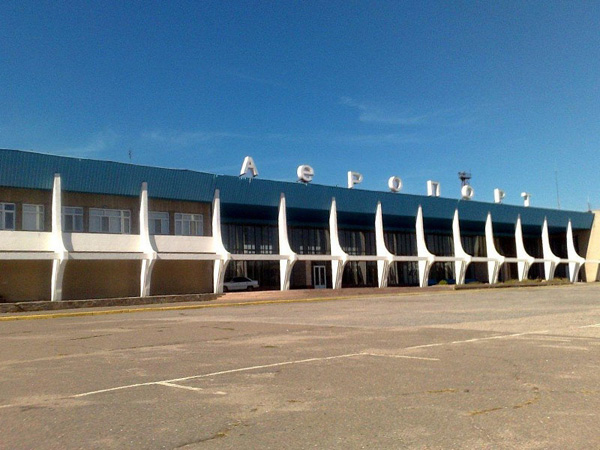
In the 1930s, before the Great Patriotic War (WW2), the airport in Mykolayiv was near the station 'Vodopoy’. The small team of the airport serviced airplanes like the Po-2 and the K-5, which flew in transit from Odessa to Kharkov. During the war, the airport had been used for a long time as a military airfield of the Soviet Union Armed Forces. When after the war the situation in Ukraine improved and there being an increase in numbers of Russian people, there was need for a civilian airport. So in 1960, Mykolayiv airport was turned into a civil aviation airport. Over time, there was a steady increase in passengers and a growing workload. Therefore, in 1975, a new runway was built. In 1983 a new terminal was constructed. During that period, the USSR was rapidly developing bigger and more powerful aircraft. In order to be able to receive and maintain (military) planes as the Tu-154, IL-76, AN-22 and IL-62 the runway was reconstructed in 1989, greatly expanding the possibilities of the airport.
In 1992, the airport received an international certification, making it possible for the airport to receive and maintain airplanes from abroad. In addition, the airport serves as a military base and as a commercial passenger airport. It provides services in the fields of transport, communications, rental of premises, storage for aviation fuel, freight, etc.
Turkish Fountain
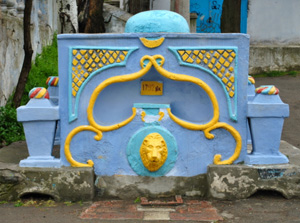
Residents of Mykolayiv still remember the local fountain with frogs and a Turkish well from childhood. This place consisted of a small eastern style house and a fountain with a lion's head from where clean drinking water flowed. It was constructed in 1792. Back then, the house of Potemkin stood on that territory. In 1842, the well-known architect K. Ackroyd redesigned it in Moorish style. As a result the place was called ‘Turkish Fountain’.
Potemkin Palace became a public city building. For many years the building served as ‘Summer Meeting’ for naval officers. During the Civil War (1919-1920), all structures except the fountain were destroyed. Therefore, the Turkish Fountain is one of the oldest structures in Mykolayiv. Now, the territory is the premises of the yacht club. Sadly, it stands neglected and looks like a conventional concrete structure from the Stalin era.
Mykolayiv Yacht Club
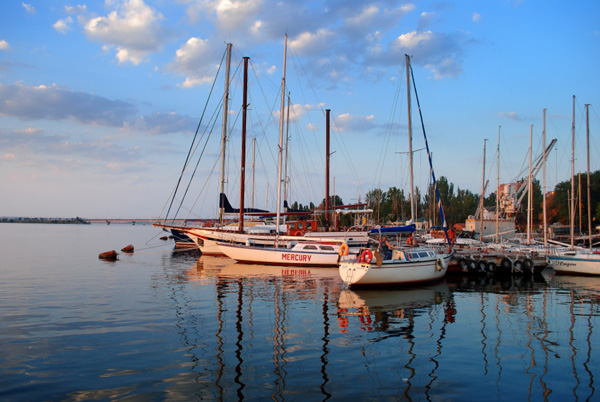
Yacht Club, not so much a Yacht Club as it is a place for fun and going out; you can have a drink, dance and have your children ride in the attractions. Being the oldest yacht club in Ukraine, it has a rich history.
The Yacht Club was opened in 1889, in an area, called Spassk, that was then considered a suburb of the city. Here was the famous Potemkin Palace, that was unfortunately not preserved, and the Turkish fountain from which round the clock water flowed from a spring. Sadly, the well went dry. But back to the end of the 19th century, captain Evgeny Golikov, historian Nikolai Arcas and academic Vladimir Rumin started the Yacht Club. Golikov was appointed secretary.
The area was cleared and the first buildings of the club were built and trees were planted. The first 66 people became members of the Yacht Club. One of them was Edward Cyber, a state councillor and Doctor of Medicine. The 'Arbor Festival' was organized on his initiative at the Yacht Club in spring of 1900. He purchased 2,000 seedlings, that were planted on the riverbanks and on the slopes. Some of these trees are still growing there today, but not in the Yacht Club. When the city government worked hard to 're-profiling' the Yacht Club into a sports complex and entertainment area, about 100 trees were cut down.
In 1904, the architect Leopold Rode built an office building. It was decorated in the Italian Renaissance style. Today, this building has the status of architectural monument and is protected by law. In the same year of 1904, several new sports facilities were built, including a tennis court, a bowling alley, a golf court, as well as a diving school.
The next 15 years were difficult, as it was for the whole country: first the Russian-Japanese war, then WO I, the revolution and a civil war. Although, the new government did not close or restructure Yacht Club. However, during the revolutionary years the club lost its best ships, but during the 1930s all the staff were restored and a summer stage was built. Films, open-air concerts and entertainment programs were performed. By this time the Yacht Club had more than 300 active members.
During the Great Patriotic War (Wo II) the Yacht Club had been hit again. Most of the boats were either stolen or destroyed. However, immediately after the war recovery began and the local shipyard quickly supplied the necessary boats. In 1949 it became possible to have the USSR championship in sailing in Mykolayiv. The next decades were a golden age in the history of the Mykolayiv Yacht Club. Sport in the USSR were well financed, and sailing developed rapidly. Our sailors steadily took the first place in competitions.
After 1991, the Yacht Club -according to the city’s inahbitants- turned into a 'coastal sewer’. For many years, the Spassk area was lined with countless stalls, tents and awnings; everywhere loud music was screaming, the area was littered with rubbish and empty bottles, and at night there often would be drunken fights. People wouldn’t go anymore and have a walk with their families, nor was it possible to sunbathe or swim.
Only in 2011, the area was cleaned up and is now again a place for entertainment and sports.
Savage Garden

Savage Garden is an old Cimmerian city, situated near the confluence of the Southern Boog with the Ingul river. Now the territory is in the city of Mykolayiv, along the bank of the river Ingul.
The garden was made by Admiral Greig. The garden was named after wild trees that do not bear fruit. Officially it is called the Admiral’s Garden, but the popular name was Savage Garden. The garden was severely damaged during the two world wars. Due to lack of firewood and coal people would take all the wood they could find, destroying the garden almost completely. After the Second World War, a wasteland was left. At the same time, buildings were erected here, but the name Savage Garden would stick.
The Belozorsky mound was opened by archaeologist Theodosius T. Kaminski on August 15th 1927. Examination of the surrounding area began in 1990. One of the first discoveries was a bronze cauldron. Presumably in the 12th century BC, there was a fortified settlement here; one of the few that survived the transition from the Bronze to the Iron Age. The northern part of a defensive wall was partly unearthed and archaeologists also discovered a temple of sun-worshipers, the proto-Mithraists. Also several pits were found, which apparently had a ritual function. They found pots with food residues (likely from a ritual), as well as stone arrows in the shape of a human. Some of the stone artifacts were of Asia Minor origin.
In the summer of 2008, a treasure was found, consisting of 12 axes (Celtic). In June 2009, archaeologists discovered something unique: the foundations of a second bridge over the moat around the fort. This finding confirmed that Savage Garden was not just a settlement with craftsmen, farmers and pastoralists, but also the regional center of the late 2nd millennium BC, with a complex social structure. New findings suggest that Savage Garden was the equivalent of a capital city of the area between the Danube and the Dnieper river, covering almost the three oblasts (provinces) of Mykolayiv, Odessa and Kherson.
Savage Garden was a proto-state; the emergence of a political structure of the Cimmerian and Scythian state. The Sabatinovskaya culture, preceding the Cimmerians and Scythians, was still a tribal community. The Savage Garden already had the beginnings of statehood. This gives a new insight in the ancient history of Mykolayiv, of the whole of southern Ukraine and of south-eastern Europe.
One can quite clearly define the boundaries of the city. The outer moat - the outer line of defense of the citadel - also had social function; to divide the population on a social level. The citadel was for the elite, priests and guards, and the commoners lived on the outside of the moat. In the citadel archaeologists found a room, that can be characterized as a repository for valuable materials.
Just a few meters from the bridge there is a large accumulation of stones, that very likely are remains of a defensive wall and watchtower, concealing the entrance to the second bridge. A moat that protected the citadel was dug, and two bridges, referred to as 'south' and 'north', were made. According to archaeologists, such complex structure can be made by people who do not just live in a community, but have a certain social structure.
Savage Garden was at the intersection of different trade routes. Therefore, it was a rich city and good defense was necessary to protect its riches. The moat was 5 m wide and at least 3 m deep. The moat, the wall and the two bridges were quite advanced for its time. According to archaeologist Kirill Gorbenko this was similar to those in Troy.
Varvarovsky bridge
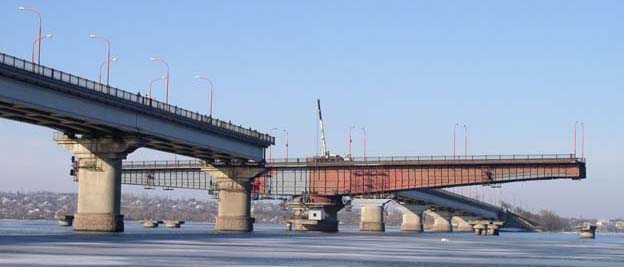
The Varvarovsky bridge spans the Southern Boog river and connects Varvarovka with the center of the city. In June 1957, construction of the Varvarovsky bridge started. This bridge was the first in Ukraine built with the 'caisson free' method. In July 1964 the bridge was opened. At that time the Varvarovsky bridge was the largest in the USSR.
Children’s town 'Fairy tale'

In the center of Mykolayiv is a wonderful children's fairy tale town, 'Ckazka' (Fairy Tale). Here, everything is done for children and parents, all from fairy tales and folklore. Until 1982, there was a market here. When it was decided that the market should be relocated, a park for children was put here. There is a wooden castle, reminding everyone about Russian folk tales. There is a stone castle from the Middle Ages too and there is also a pavilion for, for example, concerts.
In the middle of the playground is a ship with scarlet sails. Previously, the ship was called 'Desperado', but later it was renamed and was given the name 'Happiness'. The ship - though made of iron instead of wood- is a replica of the first ship that was built in the shipyard of Mykolayiv by order of Potemkin. 'Happiness' is a cozy place, where children can splash in the water. Near the ship are two real lighthouses, that illuminate the children's park when it gets dark. And not far from the lighthouse, you can ride a carousel, where you will see the characters from Pushkin’s fairy tales.
A nice feature is the sundial, that always shows you the current time. Next to the clock, you can see a cascade pool with benches and beds. And for the youngest visitors 'Ckazka' prepared a children's playground with swing sets, a slide and a sandbox. Also for kids there is are pools, a small Ferris wheel, swings and many other attractions.
The Children’s Town is also a park with rare plants. There are not only a lot of beds with tulips and daisies, there are rare trees. For example the Ginkgo tree, the oldest tree is the oldest. It has been here since the Mesozoic era.
When you are tired after a walk through the park, you can always find a bench in the shade of a tree in a fairy tale. The park has no entry fee, there is security and smoking and alcohol are prohibited. A perfect place for a nice family day or just a stroll with your children. ( )
The Mykolayiv libraries
There are 36 libraries in Mykolayiv, with a total of about 3.5 million books. Also in Nikolaev are the Scientific Pedagogical Library and many libraries of educational institutions. The oldest and largest library is the Mykolayiv State Regional Universal Scientific Library (A. Gmyryova Library). The library has a collection of 2.5 million books. Among them are rare ones, not found in other libraries in the area.
The first children's library in the city is the Regional Library for children, the V. Lyagina Library. It was founded in 1921 by Pauline Tremmer. She gathered 152 books and wanted that everyone would be able to read to their children. Today it has 163 thousand copies. The library serves 11 thousand students of different ages.
The 'Children’s reading room 1' was founded in 1923. After the war, the library was named after pioneers-heroes. Today, the Central City Children's Library (Shura Kober and Viti Khomenko Library)has more than 100 thousand books, not only for students, but also for the youngest readers.
The Regional Library for Youth was established on December 15, 1977, but in May 1985 it opened its doors for readers. It has a collection of more than 80 thousand copies.
The Central Library (M.L. Kropivnitsky Library) was founded on August 14, 1900 as a department of the Mykolayiv Public Library. From March 1922, the department got the status of 'First city district library'. In 1990 the library was named after M. Kropivnitsky, writer and actor, composer and founder of the theater for luminaries.
Scientific and Pedagogical Library - one of the three research and educational libraries in Ukraine. The library’s collection consists of 88 thousand publications. ( )
Monuments
Memorial plaque for Bouznik
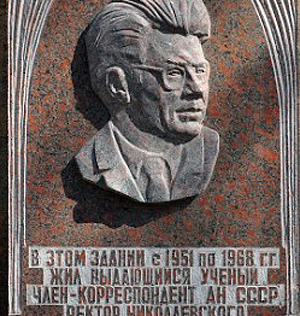
The plaque is mounted on the house, where Victor M. Bouznik lived from 1951 to 1968. Victor Bouznik was Corresponding Member of the USSR Academy of Sciences, honored worker of science and technology of the Ukrainian SSR and Academician. He was born on October 4, 1914 in Ternovca - now Mykolayiv Central District. He graduated from the Nikolaev Shipbuilding Institute.After graduation, Bouznik soon defended his thesis. He was elected as associate professor of the department "Marine steam boilers". Then head of the department of theoretical bases of heat engineering and ship steam generators.
From 1965 until 1968, Bouznik was rector of the Institute. He strengthened the teaching staff, created a new department of electrical ships, opened a number of departments and laboratories for new technologies, expanded research. The Institute strengthened ties with the industry.
Viktor Mikhailovich was always involved with social events. He was elected member of the Party Committee of the Institute, a member of the Regional Committee of the Communist Party of Ukraine, a delegate of the 23rd Congress of the Communist Party of the Soviet Union. During his life, he wrote more than 120 scientific papers. Students in many countries still use his textbooks.
Bouznik was awarded with two Orders of the Red Banner of Labor, the medal 'For Valiant Labor in the Great Patriotic War 1941-45' and other government awards. A street in Mykolayiv is named after Bouznika, as is the cargo ship 'Professor Bouznik'. nikolaev-city.com
Memorial for the 68 paratroopers in Mykolayiv
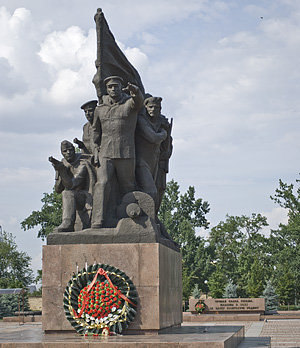
Monument of Eternal Fire is a memorіal cemetery-park complex in the centre of the city. Named in honor of the soldiers, commanded by senior Lt. K.F. Oslhansky, who landed at the Mykolayiv sea port on March 26, 1944 and after two days of heavy fighting liberated the city.
It is a sculpture of the seven figures: the combat commander, three sailors, two de-miners and a fisherman-guide, behind them are the eternal flame and the military cemetery for the 56 paratroopers. All participants of the assault were awarded the title 'Hero of the Soviet Union'.
The square is located on an area of almost 1.42 ha. in the central area of the city at the intersection of the streets Sovietskaya and Admiralskaya. The monument was first built in 1946. Reconstruction of the park and the monument was initiated in 1974 and was completed on Victory Day in May 1975. (nikolaev-city.com
Pushkin monument
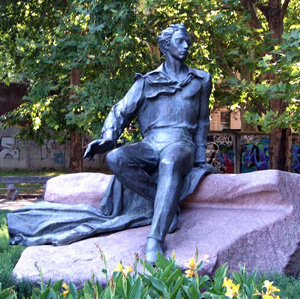
In 1820 and 1824 Alexander Pushkin passed through Mykolayiv and had a short stay. In his honor a monument had been placed, dedicated to the great poet, in 1988. It is situated at the crossing of Admiralskaya and Pushkinskaya streets. His face and gaze are looking towards the water, the element he loved so much. (www.nibulon.com)
Tank T-34
March 28, 1944, breaking the last enemy fortifications, the tank T-34 under command of General Sviridov Karp Vasilyevich first broke into the city. And 32 years on March 28, 1976, the tank again came to Mykolayiv, but now as a monument. It was put on a pedestal at the intersection of Lenina and Komsomolskaya streets, reminding that the city was liberated on March 28, 1944. The tank has number 283.
Partisan obelisk
March 27, 1969, on the eve of the 25th anniversary of Mykolayiv’s liberation, a monument was erected in the cemetery. The monument is dedicated to the partisans and the underground resistance, who fell in the fight against the fascist invaders. On the top of the granite obelisk is a bronze face of the Sorrowful Mother and at the bottom are carved the faces of three nameless characters.
Memorial spire
The memorial site dedicated to the liberators was opened in 1967 at the intersection of Lenina and Dekabristov streets. At its center was a tall spire was erected with the image of the Eternal Flame. The bas-reliefs on the stele tells about the courage of Soviet soldiers and of mothers mourning for their dead sons. On a concrete slab is the inscription: "The honorary title 'Nikolaevsky' was given to" followed by a list of divisions, battalions and detachments.
Monument of Viktor Lyagin
At the end of 1941, Viktor Lyagin came to Mykolayiv. He created the organization 'Mykolayiv Centre'. Its purpose was disrupting Hitler’s plan on hijacking local youth to Germany. His life was ended by the Gestapo in April of 1943. In memory of V.A. Lyagine one of the streets is named after him. In 1974 at the intersection with Lenina Prospekt, a bronze bust was placed. It is mounted on a pedestal of red polished granite. On the front is an inscription of the Star of the Hero and the text 'Hero of Soviet Union Lyagin V.A.'.
Shura Kober and Viti Khomenko
Shura Kober and Viti Khomenko were members of the reconnaissance group V.I. Andreeva (Palagnyuk) during WWII. They did a lot to frustrate the German occupiers: disclose secret intentions of the enemy, undermine trains and crossing the front line to bring important reports to the partisan headquarters. However, in November 1942, the boys were caught and on December 5, 1942, they were executed. In Pioneer park is a monument for these young patriots. On a high pedestal there are two bronze figures. On the granite slab the words: "Pioneers-heroes, young scouts Shura Kober and Vite Khomenko, who died fighting the invaders December 5, 1942, from the pioneers of Ukraine" are inscribed.
Victory monument
On May 6, 1985, at the intersection of Mira and Kosmonaut streets, the monument 'Victory’ was erected, showing 'Victory' and '1945-1985'.
Konstatin Fedorovich Olshansky
At the entrance of the Mykolayiv seaport stands the bust of Konstantin Olshansky.
Soldier’s monument
In Victory park is a monument, reminding us of the war. It is a monument from the Soviet era dedicated to the soldiers who fought in any war the Soviet Union fought at different times. Warriors-Internationalists (a common name for these soldiers) fought in Vietnam, Korea, Afghanistan and other countries.
Michael Faleyev
At the waterfront stands a bronze monument dedicated to the 'foreman and gentleman' Michael Faleyev. The small area in front of the monument has the informal name 'Faleeva Square'.
Ignaty Shevchenko
The monument dedicated to the sailor Ignaty Shevchenko was installed in 1874 at the naval barracks, commemorating his heroic deeds defending Sevastopol. On the night of 19-20 January 1855, Ignatius Shevchenko shielded his commander with his body and got shot in the chest. In 1903, the monument was transferred to Sevastopol. Now, the monument had been rebuilt in the same spot.
Bogdan von Glasenapp
A monument for Bogdan von Glasenapp (1811-1892) in Mykolayiv. He was the military governor of the city for 11 yearse. It was a difficult period for Russia then: the Crimean war, famine, the collapse of the military shipbuilding. Glasenapp revived Mykolayiv and made it a center of industry, education and culture in the south of Russia.
Nikolai Arkas
Nikolai Nikolaevich Arkas - historian, ethnographer, educator, composer, founder and leader of the organization 'Enlightenment. On Admiralskaya street there stands a monument, to perpetuate the memory of the famous Arkas. It stands where once his house was. The memorial sign was officially opened on October 27, 1992.
Daniel Samoilovich Samoilovich
Among the remarkable people in the history of Mykolayiv, is the famous Russian military surgeon Daniel Samoilovych Samoilovych. He first proposed the idea to treat the wounded in front-line hospitals, as well as the first to use quarantine isolation. D. S. Samoylovich died in 1805 in Mykolayiv. In 1969 in commemoration of his 225th birthday, a bronze bust was set on the territory of the regional hospital, in the woods.
Zoo statue
In 1978 near the main entrance of the zoo, a statue was installed depicting Jungle Book’s Mowgli and his friend Bagheera. The figures are made of copper and stand on a granite base. In 2001, the Mykolayiv Zoo celebrated its 100th anniversary. The zoo is rated among the ten best zoos in the world. It doesn’t only show the variety of the animal world, but also preserves rare and endangered species.
Prometheus monument
According to the ancient Greek myth, Prometheus stole fire from Olympus and gave it to the people, for which he was chained to a rock and doomed to eternal torment. This monument of Prometheus was erected at the entrance of the plant 'Crystal' in 1978. Under the five-meter figure in the granite pedestal the words: "Give the fire, like Prometheus, and for the people you do not feel sorry for the fire" are carved.
Saint Nicholas
At the beginning of the 21st century the townspeople erected a monument dedicated to Saint Nicholas the Wonderworker. It is located in the heart of Nikolaev, in Chestnut park. Nicholas - the Christian Saint, who has miraculous power and who heals the sick, stops storms and rescues drowning people. Sailors regard him as their patron saint, who protects their ships and gives them courage and strength. Nicholas also protects the poor, and gives presents to children.
BANDS AND SINGERS
Okean Elzy
Jamala
The Hardkiss
Tina Karol
Christina Solovy
Piccardysky Tertsiya
advertisement
Ruslana
Skryabin
Alyosha
Olexander Ponomarev
Zlata Ognevich
Onuka
advertisement
Antityla
Loboda
Irina Dumanskaya
Irina Fedishin
Vivienne Mort
Krykhitka Tsakhes
advertisement
S.K.A.Y.
Druha Rika
Boombox
Buv'ye
Lama
Platch Yeremy
advertisement
Voply Vidoplasova
T.N.M.K.
Tartak
Noomer 482
Braty Hadukyny
O. Torvald
advertisement
Bahroma
Epolets
Haidamaky
TIK
Ani Lorak






